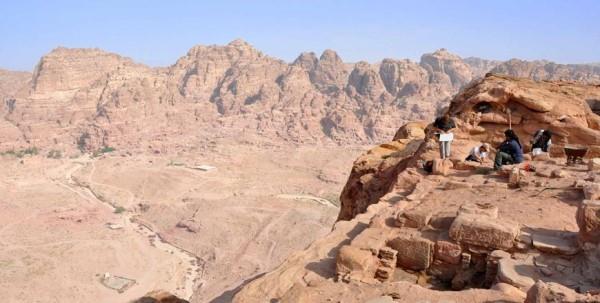
3rd int'l conference on Petra explores Nabataeans' economic heritage
The four-day event, titled 'The Nabataeans-Economy and Culture', was organised by the University of Jordan and Petra Development and Tourism Region Authority (PDTRA) in Petra between June 18 and June 21.
'Petra is the main tourist site in Jordan, but it is the symbol of the Jordanian national identity,' said Chief Commissioner of PDTRA Falah Al Omoush, adding that despite the conflicts and turmoil gripping the region since the Arab Spring, the last two years have witnessed an increase in the number of tourists, and PDTRA works with both local and international stakeholders to boost Petra's tourism.In the opening speech on Monday, a day before the official beginning of the scientific programme, Deputy Chief Commissioner of PDTRA Suleiman Farajat stressed: 'There are nations that have no past, so they invent some, and there are nations that have deep past, as it is the case of Jordan, which is being imagined, negotiated and celebrated by its people in different forms.'
'Being an important city under Roman occupation and Byzantine influence up to the Crusaders' period in the 12th century, Petra seems to have been away from the world until it was rediscovered to the Western world in 1812, marking a new era of interest and rediscovery,' Farajat said, underlining that most travellers at that time entered it from the south as they came from Egypt accompanied by bedouins from Aqaba and Sinai who acted as 'the first Jordanian tour operators'.The encounters of those travellers with the diverse local groups at that time showed the fragmentation the society lived in, but also the lack of appreciation and understanding of the site, he explained, adding that there is 'no wonder that most of early travellers were certain that Petra was a Roman city'.
'It was only after the archaeologists started to study Petra in the early 20th century that the Arab identity of Petra was clear,' Farajat noted.The importance of Petra in the incense trade was very well documented by ancient sources.
'The Nabataean role in the trade of frankincense and myrrh for use as incense and in perfumes is well documented,' said David Johnson from Brigham Young University in Utah, in the US.According to Johnson, who worked as a researcher in Jordan from 1977, the role the Nabataeans played in the trade of these products and other plant products, such as rock rose in medicine and magic, was not often discussed.
In his paper titled 'Magic, Medicine and Fraud', the role of the Nabataeans in this trade is examined by looking at the literary evidence from ancient writers such as Dioscorides(40-90 AD), Pliny( 23-79AD) and Galen(130-210 AD); the Greek magical papyri; and a botanical survey of present day plants found at Petra.Another source is the archaeological evidence from Nabataean sculpture, painting and pottery, the American scholar continued, adding that among the major plant products exported by the Nabataeans, three — frankincense, myrrh and bdellium — originated outside of Nabataean state while others, iunctus odoratus, gum labdanum, balanites oil and terebinth resin were produced in Nabataea itself.
Laurant Tholbecq, from University of Brussels, talked about a complex system of taxes which Nabataeans imposed on caravans, land property and individuals. According to Pliny, 'the Nabataean Kingdom taxed caravans, which was a significant source of income'.French architect Thibaud Fournet studied Petra's baths, which are located on 300-metre cliff edges above the valley, and were excavated in 2012 and 2015.
'The breathtaking location of both buildings, on the edge of the cliff, overhanging the valley by circa 300 metres, was deliberately decided,' Fournet said.Swiss researcher and resident of Petra Ulrich Bellwald presented the number of winery presses in the Beidha area and speculated that wine production was the state monopoly in ancient Nabataean Kingdom.
'In Nabataean period it was absolutely impossible to influence the fermentation process by cooling. Due to the still very high temperatures during harvest and due to the fact that the bedrock, into which the wine presses were inserted, was at least warm, fermentation concluded within a timeframe of not more than one day,' Balwald highlighted.Hence, the production process in the presses took place in short intervals to avoid a secondary fermentation which would have turned the wine into vinegar, the harvest only started at the last possible moment, with the grapes having a high concentration of sugar, the veteran scholar explain, adding that 'as there is only a very limited number of shards belonging to locally manufactured wine amphorae known from the Petra area, the wine was most probably stored and transported in wineskins from goats or/and sheep'.

Legal Disclaimer:
MENAFN provides the
information “as is” without warranty of any kind. We do not accept
any responsibility or liability for the accuracy, content, images,
videos, licenses, completeness, legality, or reliability of the information
contained in this article. If you have any complaints or copyright
issues related to this article, kindly contact the provider above.


















Comments
No comment